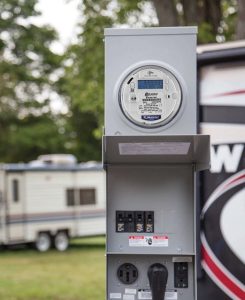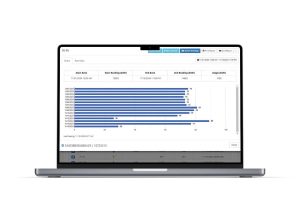
Automated Meter Reading Systems Help to Streamline Marina Operations
Published on April 1, 2025Marinas are continually looking for ways to provide excellent customer service while also keeping an eye on the future. Driven by advancements in metering technologies, the marina industry is undergoing a significant transformation. New targets are enhanced efficiency, accuracy and user satisfaction as manual meter readings are giving way to automated systems, aligning marinas with modern smart infrastructure trends.
Metering Innovations
Smart Automated Meter Reading (AMR) systems have emerged as a pivotal innovation for marinas. MarineSync is offering technology to streamline utility monitoring. “By leveraging advanced IoT-based solutions, we are revolutionizing utility metering,” said Austin Bleier, president of MarineSync.
“With the RUM (Remote Utility Monitoring) system, we are providing marinas with real-time insights, automation and cost-effective energy management.”
Bleier said most marinas are still using manual readings, walking docks monthly with a clipboard. “The greatest savings with wireless metering is labor, but it also helps alleviate billing disputes and unauthorized consumption while providing more accuracy,” he said. “It provides all-around operational efficiency.”

By providing scalable technology, this wireless system can support marinas of all sizes — from just a handful of slips to corporate-owned facilities with multiple locations and data aggregation requirements.
The facilitation of real-time monitoring of utilities like electricity and water leads to precise consumption tracking and efficient billing processes. Seamlessly integrating and retrofitting wireless technologies onto existing meters reduces manpower and ultimately decreases operational costs.
“Our transponders and gateways collect and transmit real-time data from individual slips,” Bleier said. “By wirelessly connecting meters to a cloud-based platform, we create a seamless and streamlined operation. Our system is also fully integratable with existing billing and accounting marina management platforms, along with environmental tools for sustainability tracking.”
MarineSync’s meters provide revenue-grade accuracy and are approved by the Department of Weights and Measures, which ensures that boaters are billed correctly. The system uses encryption and redundant data transmission coupled with cloud-based storage to prevent data loss. Wireless signal integrity is maintained even in harsh marine environments, through advanced radio frequency (RF) engineering and tireless testing.
The Internet of Things (IoT) is playing a transformative role in marina operations. With connectivity and data-driven information, safety is enhanced through bolstered security measures in the form of sensors that can alert operators to potential hazards or unauthorized activities.
Marina Electrical Equipment (MEE) specializes in designing and manufacturing weatherproof electrical equipment specifically for marinas and boatyards, providing essential power sources like power outlet panels and power distribution equipment that allow boats to connect to shore power while docked.
“The software and electronics industry is a fast-paced and innovative space that sees new improvements and upgrades on a daily basis,” said Kelly Treiber, president and CEO of MEE. “Marina metering systems have been able to take advantage of the steady stream of advances and harness new designs and component technology to improve the accuracy of readings as well as improve the customer experience using them.”

Trieber said MEE manufactures products that offer features like ground fault protection, metering and water access all within a single unit, crucial for safe and convenient boat operations at marinas.
MEE provides increased operational efficiency to marinas through their NuCore Remote Read metering technology, which eliminates walking the dock to manually record kWH readings.
The optional NuCore metering system utilizes Mesh network transceivers within the kWH meter assembly that wirelessly transmit individual meter readings to a central base station.
“The marina can obtain real-time readings through the NuCore system software and directly import readings into their management software platform,” Treiber said. “This system significantly reduces time and labor expenses as well as eliminates potentially costly clerical errors, thereby increasing marina operational efficiency. “
MEE also manufactures each component of this system to include all of the hardware, software and installation to ensure that marina customers have single-source contact and support.
In keeping up with a boating industry that has seen the size and power requirements of vessels increase dramatically along with a constant evolution of various electrical codes and standards, MEE has developed and refined ways to provide cost-effective solutions. In response to the stringent electrical code changes, the company developed Sentinel Series Protective Ground Fault Relays.
“These are used in all power pedestals and electrical distribution equipment,” Treiber said. “These devices were designed with the end-user and customer in mind as they provide both visible and audible alarms when a potentially dangerous ground fault has been detected.”
This eliminates the typical “goose chase” that happens when a standard ground fault circuit breaker trips, often leaving the end-user clueless as to the cause.
Adapting and Training
The switch to wireless metering doesn’t come without some challenges. Older facilities may require upgrades due to infrastructure limitations. In addition, staff adaptation through training and onboarding is imperative to ensure smooth adoption of the program.
“We work to address these challenges head on through site surveys, customized deployment strategies and ongoing technical support,” Bleier said.
“We are glad to report that the metering systems we produce are robust, intuitive and quite user friendly,” Treiber said. “But the single most challenging aspect the marina operator faces in managing energy consumption and billing is operational. The kWh meters are only useful if they are read consistently and accurately. Simple clerical mistakes as small as a missing decimal point can result in over or undercharges leading to lost revenue or unhappy customers.”
When the hardware is produced by one manufacturer, the software by another, and installation is performed by yet another, marina customers may pay the price – especially during malfunctions – when no single element can be blamed or nobody will claim responsibility. This can leave the system inoperable for extended periods of time, putting a financial strain on the marina. Having an operational, cohesive program in place can eliminate those problems.
Environmental Impacts
With the assurance of accurate billing, boaters are able to gain insight into their consumption patterns, which empowers them to not only be more aware, but to become more proactive and conscientious in managing their utility and resource usage. This ensures a positive environmental impact.
With the MEE metering systems, contributions to sustainability and environmental responsibility come about almost organically.
“This is due to the simple fact that when a customer knows they are being charged for metered usage, they are more likely to conserve power,” Treiber said. “Interestingly, the National Electrical Code even allows an additional 10% deduction in the load calculations as a result, which reduces the marina’s total energy usage requirements.”
Those savings also show up in more tangible ways, according to Bleier.
“Wireless metering contributes to sustainability by reducing energy waste through real-time monitoring,” he said. “On top of that we are eliminating paper-based utility tracking and encouraging eco-friendly boating practices. This reduces unnecessary energy consumption and improves efficiency.”
Safety and Security
With wireless technology, security is always a concern. By making it a top priority, unexpected problems can be mitigated.
“We ensure security through various important avenues,” Bleier said.
Those include end-to-end encryption for data transmission; secure cloud storage with multi-layer authentication; regular software updates to prevent vulnerabilities; and access control management for marina administrators.
Future Technology
With wireless systems, marinas can identify and reduce excess consumption while promoting a “pay for what you use” system as opposed to utilities included in slip rates.
Future systems are also expected to offer user-friendly interfaces, allowing boaters to access real-time data, set consumption alerts and manage their accounts digitally. Advanced analytics push the envelope further by enabling predictive maintenance of marina infrastructure, reducing downtime and extending the lifespan of equipment.
Bleier said MarineSync is already developing next-generation metering solutions that will impact the industry.
“We are working on AI-driven energy optimization to predict and manage usage,” he said. “One of our priorities is integration with solar and renewable energy tracking as well as advanced water monitoring for leak detection.”
Other upcoming offerings that Bleier is excited about include an enhanced mobile app functionality for boaters to track their own usage in real time and automation with Edge-intelligence.
MEE is currently working on plans to overhaul the NuCore software platform, not only with a software upgrade, but moving it from being locally hosted to a cloud-based application.
“We are certainly keeping a watchful eye on the state of the industry and where it seems to be headed,” Treiber said. “The current hot topic is the steadily increasing interest and demand for electric boats, which is driven by rising environmental concern as consumers seek more sustainable options.”
While benefits to boaters are substantial, marinas can face a major challenge and cost in upgrading infrastructure to accommodate fast-charging stations, which require considerable output.
“One thing is for certain: marinas have their work cut out for them if the trend toward electric boats really takes off,” Treiber continued. “Regardless, we are prepared to produce all necessary electrical equipment to facilitate the incorporation of power-consuming fast-charging equipment for electric boats, including switchboards, panelboards, unit substations, transformers and electrical design assistance.”
The evolution of metering technologies is revolutionizing marina operations, offering benefits that extend from operational efficiencies to enhanced user experiences and conservation efforts. As marinas continue to embrace these innovations, the industry sets itself up for a future characterized by smart, sustainable and user-friendly environments.
| Categories | |
| Tags |





